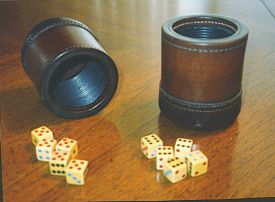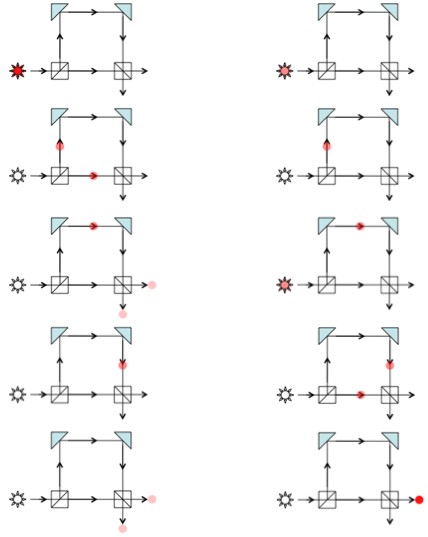Physicist: There are a lot of subtleties to this. Reading the question, your gut reaction should be “Duh, it’s 100%! Wait, is this really a question?”.
And yet, there are many times in which you may find yourself estimating probabilities on things that have already happened. If you flip a coin and cover it or go looking for a lost dog, the “true” probability is always 100%: the coin is definitely either heads or tails, and Fluffins (the wonder dog) has a 100% chance of being exactly where it is.

In liar’s dice all the bets and estimations are based on events that have already occurred, but are unknown.
Probabilities are usually defined in terms of the uncertainty in what’s known. Liar’s dice is a beautiful example (so are most card games for that matter); all of the dice are what they are, and yet in the picture above, if you’re the player on the left, then there’s a chance of 1 that all of your dice are 5’s, but there’s an even chance that your opponent’s dice could be any combination. From the left player’s perspective, there’s some chance that the dice on the right are, say, “1,2,3,4,5”, even though from the right player’s perspective, that chance is zero (the right player knows their dice are not “1,2,3,4,5”).
Long story short: probability is extremely subjective. Whether an event happened in the past or will happen in the future doesn’t make too much difference, it’s the knowledge you have about an event that defines its probability (for you). That said, in terms of gaining knowledge about an event, it helps a lot for it to have been in the past. If you were some kind of time traveler it would be a lot easier to determine the result of a coin toss by just looking at it after it’s happened, rather than going to the trouble of predicting it before it’s happened. That’s why there are Futures Markets, but not Pasts Markets.
But the spirit of this question is really about some kind of “objective probability”. Maybe you don’t know how something in the past turned out, but surely if you somehow had access to all of the information in the universe you’d be able to determine that the probability is 100% or 0%. Surely everything in the past either happened or didn’t, it’s just a matter of finding it out.
Very, very weirdly; no. You have to root around in quantum mechanics to see why, but it turns out that even things in the past, in the most objective possible sense, are also uncertain. This doesn’t mean that, for example, the Nazi’s may have won the war (since it’s pretty well-known that they didn’t), but it does mean that if an event is so small and fleeting that it leaves no real trace, then it may have happened in multiple ways (quantum mechanically speaking).
Answer gravy: This is high on the list of the weirdest damn things ever.
Way back in the day, the double slit experiment demonstrated that a particle (and later much larger things) can literally be in two places at once. This means that the question “where did I leave my quantum keys?” doesn’t have a definite answer. The probability that the particle will be found going through one slit or the other is non-zero, not just because the position isn’t known, but because it can’t be known (essentially, there’s nothing definite to know). The first reaction that any half-way reasonable person should have is “dude, you missed something, and that particle totally has a definite position, you just don’t have a way to figure out what it is”. But physicists, being clever and charming, found a way to prove that that isn’t the case. It can be shown that, regardless of what you do or how you measure, quantumy things don’t have a definite position. This is basically what Bell’s theorem is all about.
Not comfortable with reality being merely a little weird and uncomfortable, a dude named Franson proposed an experiment to demonstrate that the past is in a similar superposition of states. Not only can things be in multiple places now, but they can do it at multiple times.
In the Franson experiment a photon is emitted at a random time and shot toward a beam splitter, which allows it to take one of two paths; a long path and a short path. You’d “expect” that the photon would be emitted at a particular time, then take one (or both) paths, and then randomly exit (diagram below). The thinking is that, since the two versions of the photon arrive at the second beam splitter at different times, there’s no way for them to interfere.

The Franson experiment: You’d think that a photon would be emitted at a definite time (left) and then move through the paths and exit randomly, either sooner or later. But (right) we find evidence of interference at the exit, so the photon must exit at one time and enter at two.
However! When this experiment is done (with a random photon source) interference is seen. Therefore the photon must be arriving at the second beam splitter from both paths (similar to how the double slit experiment creates interference). But that means that the photon must have been released at two different times.
There’s some subtlety that I’m not including, such as the fact that paths above are only half of the device (the other half is identical), and that the experiment requires entangled photons, but if you’re interested in the details you can read the original paper.
What’s really horrifying is that this experiment is done pretty regularly! Nothing special. The past genuinely is in multiple-states, and as a result the probabilities of events in the past can be damn near anything.







11 Responses to Q: What is the probability of an outcome after it’s already happened?